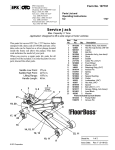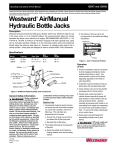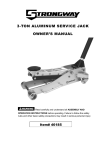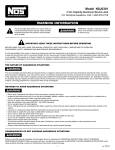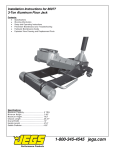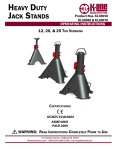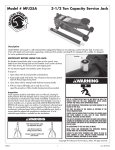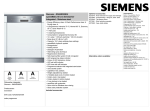Download Operation , Service & Maintenance Guidelines Weaver
Transcript
® Weaver Jack Operation and Service Instructions WA-72B 2 Ton Model WA-73B 4 Ton Model 1 WA-75B 10 Ton Model WA-85 20 Ton Model • • • • • 2 Manual Contents: New Jack Assembly Jack Operation & Use Preventive Maintenance Trouble Shooting & Adjustments Weaver Jack Model Specifications MODEL CAP. FRONT WHEELS SADDLE STYLE (tons) AND SIZE FRAME LENGTH JACK WEIGHT WA-72B 2 Two - 4" Diameter Triangular or Round 5"' to 6" 51" 136 lbs WA-73B 4 Two - 5" Diameter Triangular or Round 5" to 6" 58" 212 lbs WA-75B 10 Two - 7" Diameter Round 9" 66" 356 lbs WA-85 20 Three- 7" Diameter Square 7" 69" 531 lbs WA-72B (2 ton) WA-73B (4 ton) WA-75B (10 ton) WA-85 (20 ton) 3 To Assemble Your New Weaver Jack 1. Check the handle set screw for tightness. 2. On the WA-85 20 Ton Jack only--Remove and discard the vent filler plug. This is very important, as the vent hole must always be kept open so the Jack can "breathe.”. The other models have a breathable vent built into the cap. 3. Loosen the Piston Ram and Pump Packing Nuts slightly. They are tightened all the way down at the factory for shipment. Tighten until no oil seeps out. They only need to be moderately tight. To Operate the Jack WARNING: Always use stands to support vehicle before attempting under vehicle repairs or Inspections. Always follow OSHA Workplace Safety standards. 1. Use the Jack on a smooth, hard and level surface only. Use the Jack only as a lifting device only. 2. Test the Jack by using the foot pedal only to raise the saddle to full height without a load. The pedal should become very tight. If not, check the oil level or see the troubleshooting section. 3. The Jack is easily maneuvered by depressing the Handle Lock Lever until the lock rod engages one of the two handle positions, and then pivoting the Jack on Its rear casters. 4. Place the jack in position so that the saddle will engage an approved lifting area of the vehicle. The saddle is raised to the contact point by the foot pedal. Lift the load using the long handle – do not lift loads with the foot pedal alone. On low clearance vehicles It Is often advantageous to operate the foot pedal by hand while watches to assure proper saddle contact. Surface on which Jack rests should be fairly flat to prevent twisting of the frame. Load should be centered in the saddle. 5. Pump with handle for easy lifting. Do not attempt to raise the jack beyond its travel stops. 6. To lower the load, pull back gently on the release lever. Always lower the load slowly. 7. Be certain that area beneath vehicle is clear before lowering the vehicle. Always use the release lever lock to prevent unintentional operation of the release lever. 4 To Refill with Oil Remove the filler plug and with the saddle DOWN put InAW-32 Light Hydraulic Oil (or oil that meets MIL•F•17111 011 specifications) until the level comes up to within 1/4" to 3/8" below filler hole. Overfilling will cause oil to spurt out the vent hole as the Jack Is lowered, or may' prevent jack from lowering properly. Insufficient oil will cause the Jack to 11ft only part way. Always be sure to put in oil only when the saddle is all the way down. Be careful not to let any dirt get into the reservoir while the Filler Plug Is out. Do not use brake fluid, transmission fluid or any other fluids—doing so could damage the seals and cause jack failure. Overload Protection The Lowering Valve (Release Valve) is also designed to work as an overload protection device. If you attempt to raise a load that exceeds the jack’s rated capacity, this valve will automatically release the cylinder pressure as an overload protection safety feature. Safety Precautions Follow OSHA Standards and ASME PALD Part 10 Instructions. Never exceed the Jack’s rated load capacity. Only lift vehicles at the recommended lift points found in the vehicle’s service manual. Eye protection should be worn per OSHA recommendations. Always use the Jack on smooth, hard and level surfaces – while keeping the load centered on the saddle. Always check the Jack prior to each use – do not attempt to use the Jack if any defect is observed. Do not add accessories or modify the Jack in any way. Always use Jack Stands under the vehicle and stay clear when lifting or lowering the vehicle. Preventive Maintenance 1. Inspect the jack before each use. Take corrective action before using the jack is a leak or defect is found. 2. Keep all working parts thoroughly lubricated. Keep Jack clean. Dirt is the major cause of Jack failure, and all openings should be kept free of debris. 3. Packing nuts at the piston and pump plunger should be kept moderately tight. These Packings are NOT under high pressure, and should only be tight enough to prevent leakage. 4. Keep oil filled to within 1/4” to 3/8” of fill opening. Replace oil at least once a year. 5. Ball Valve may be removed for Inspection and cleaning by removing the Ball Chamber Plug [V] and using a small magnet, remove the balls [X&Z] and the ball weight[Y]. See Diagram IMPORTANT: Whenever it is necessary to loosen or remove the Ball Chamber Plug, the Gasket [W] should be replaced with a new one. Oil leakage at this point is usually caused by trying to reuse an old gasket over again. 5 Troubleshooting SYMPTOMS CORRECTIVE ACTION 1. Jack will not raise saddle. 1. Check the oil level. 2. Perform the Ball Valve Test 2. Oil spurts out the vent hole. 1. The jack is overfilled with oil. 3. Jack will only lift part way up. 1. It may be low on oil. Check and refill. 4. Jack will not lift a load. 1. Check for proper oil level. 2. If pumping falls to raise the rated load, the lower ball valve may be leaking, and it should be inspected for dirt or other obstructions. 5. If the load rises on the down stroke of the handle and then immediately settles back down while forcing the jack handle up. This means that the upper ball valve may be leaking, and it should be inspected for dirt or other obstructions. 6. Jack bleeds down while under load. 1. The Release Handle may not be closed 2. The Release Valve may be leaking. Replace the release valve packing housing “O” Rings. 3. The Release Needle Valve may need to be adjusted. 7. Jack only rises on half-stroke, and then settles back down while forcing the handle up. This means that the jack may be Air Bound. To Relieve When Air-Bound 1.Should the oil supply run too low, the Jack may become air-bound and work on only a half stroke of the handle. Fill the jack with oil, and then raise the saddle, and then using the Release Lever (lowering lever) lower the saddle while holding the fool pedal depressed. This will flush out any air in the system, and excess oil may then run out of the vent. Repeat if necessary. Be sure that the jack is properly filled with oil before putting it back in service. Oil should cover the piston rod. If you cannot pump the Jack Saddle to full height, raise the Saddle by hand and then perform this operation Ball Valve Test. If the Jack will not raise at all, then the Ball Valve may be obstructed by debris. Open the Release Valve and keep it open. Raise the Saddle lift arm manually to full height. Now lower the Saddle by pushing it all the way down – this will flush out any debris in the Ball Seats. Close the release valve and try to pump up the Jack. If it now will raise and hold, then the Ball Valve may need to be serviced. 6 Release Valve Group (upper ) - Pump Assembly (lower) Release Valve Group and Ball Valve Assembly Derail Ball Valve Replacement Ball Valve Replacement: 1. Remove the Ball Chamber Plug [V]. Remove the Two Balls [X&Z] and the Ball weight [Y]. 2. Reassemble with the two new Balls [X&Z], New Plug Gasket [W] and Ball Weight [Y] (reuse the existing Ball weight). Ball Weight is installed between the two balls. IMPORTANT: Whenever it is necessary to loosen or remove the Ball Chamber Plug, the Gasket [W] should be replaced with a new one. Oil leakage at this point is usually caused by trying to reuse an old gasket over again. 7 Release Group - Needle Valve Adjustment Release Group Needle Valve Adjustment: In the release group assembly, the spring governs the load that the Jack will lift. When the pressure within the cylinder overcomes the spring tension then the release valve floats off the seat. It is Imperative that the release valve floats freely in the release group assembly. To check- use your forefinger and thumb to grasp the release valve where the release clevis pin passes thru, and wiggle from side to side. There should be a minimum of .002 to.004 clearance in the Release Vale Guide [OO]. If no movement is noted, follow these steps: Refer to the above Diagram. Measure accurately the distance from the Bracket [O] to the first Nut [P] on the compression spring. Write this measurement down. (This is approximately 2 inches) Remove Nuts [P] & [Q], the Spring, the Valve Rod [N] and the Valve Guide [OO]. It is not necessary to loosen the Packing Nut. Next, insert the Valve Rod [N] thru the Bracket’s [O] opening, slide the Release Valve Guide [OO] onto the rod, but not seated in the hole, and insert the rod [N] into the Packing Nut’s [R] opening. Gently Tap the end of the release rod [N] with a hammer until it stays firmly seated in the internal needle seat. Slide the Release Valve Guide [OO] towards the Bracket [O] (normally it will smoothly fit into the bracket hole) and then noting where the center alignment of the rod in the bracket hole is off -- Tap the welded bracket accordingly with a hammer to gently bend the bracket and correct the misalignment. It is in alignment when you can smoothly slide the Valve Guide into the Bracket’s hole. Reassemble the Release Valve and parts. Tighten the adjusting nut [P] to the original dimension that you wrote down and lock this nut with Nut [Q] and then test the Jack for proper operation. Seal Kits for Weaver Jacks are available from Castle Equipment Company.. TIP – It is best to order the complete kit initially, rather than order individual parts, as it usually turns out that you will need multiple, if not all the parts in the Kit. You will end up saving money, as individual part prices will exceed the kit cost, not to mention that you would incur additional shipping costs. 8








